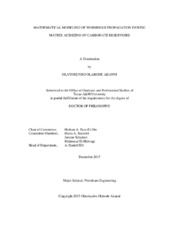| dc.contributor.advisor | Nasr-El-Din, Hisham A | |
| dc.creator | Akanni, Olatokunbo O | |
| dc.date.accessioned | 2016-05-04T13:21:44Z | |
| dc.date.available | 2017-12-01T06:36:17Z | |
| dc.date.created | 2015-12 | |
| dc.date.issued | 2015-11-28 | |
| dc.date.submitted | December 2015 | |
| dc.identifier.uri | https://hdl.handle.net/1969.1/156460 | |
| dc.description.abstract | This study demonstrates the application of an alternative formulation to effectively describe the flow field in a two-scale carbonate matrix-acidizing model. The model is further modified and extended to alternative acidizing fluids such as chelates and organic acids. Existing carbonate acidizing models in the literature are analyzed for their accuracy in field-scale application, and recommendations are made for the best methods for obtaining optimum injection and wormhole propagation rates. Finally, a selection procedure for acids and additives is developed to aid in designing an optimal carbonate matrix acid treatment.
The fluid field flow in this two-scale model is described by the Navier-Stokes momentum formulation. The model is implemented via a commercial computational fluid dynamics package to solve the momentum, mass conservation, and species transport equations in the Darcy scale. The software is combined with functions and routines written in the C programming language to solve the porosity evolution equation, update the pore scale parameters at every time step in the simulation, and couple the Darcy and pore scales. A nonlinear kinetics equation which accounts for the weak dissociation of organic acid is used to describe the reaction of acetic acid with limestone in the modified model.
The output from the model is consistent with experimental observations, and the results from various sensitivity tests performed are in agreement with previously developed two-scale models based on the Darcy formulation. Numerical simulation results also showed that the optimum injection rate obtained in laboratory coreflood experiments cannot be directly translated for field applications due to the effect of flow geometry and medium dimensions on the wormholing process. The simulation runs from the modified model for acetic acid produced output that matched experimental results, but the output for chelating agents does not quantitatively match with experimental results.
The model in this work is computationally less expensive than previous Darcy-Brinkman-based model. The simulations at very high injection rates with this model require less computational time than those developed with the Darcy formulation. For field treatment, it is recommended to inject the acid at the maximum allowable rate, and monitor wormhole propagation using the modified semi-empirical model. | en |
| dc.format.mimetype | application/pdf | |
| dc.language.iso | en | |
| dc.subject | Carbonate matrix acidizing models | en |
| dc.subject | Wormhole propagation rate | en |
| dc.subject | Optimum injection rate | en |
| dc.subject | Dissolution patterns | en |
| dc.subject | Acidizing fluids selection | en |
| dc.title | Mathematical Modeling of Wormhole Propagation during Matrix Acidizing of Carbonate Reservoirs | en |
| dc.type | Thesis | en |
| thesis.degree.department | Petroleum Engineering | en |
| thesis.degree.discipline | Petroleum Engineering | en |
| thesis.degree.grantor | Texas A & M University | en |
| thesis.degree.name | Doctor of Philosophy | en |
| thesis.degree.level | Doctoral | en |
| dc.contributor.committeeMember | Barrufet, Maria A | |
| dc.contributor.committeeMember | Schubert, Jerome | |
| dc.contributor.committeeMember | El-Halwagi, Mahmoud | |
| dc.type.material | text | en |
| dc.date.updated | 2016-05-04T13:21:44Z | |
| local.embargo.terms | 2017-12-01 | |
| local.etdauthor.orcid | 0000-0001-9026-7283 | |


